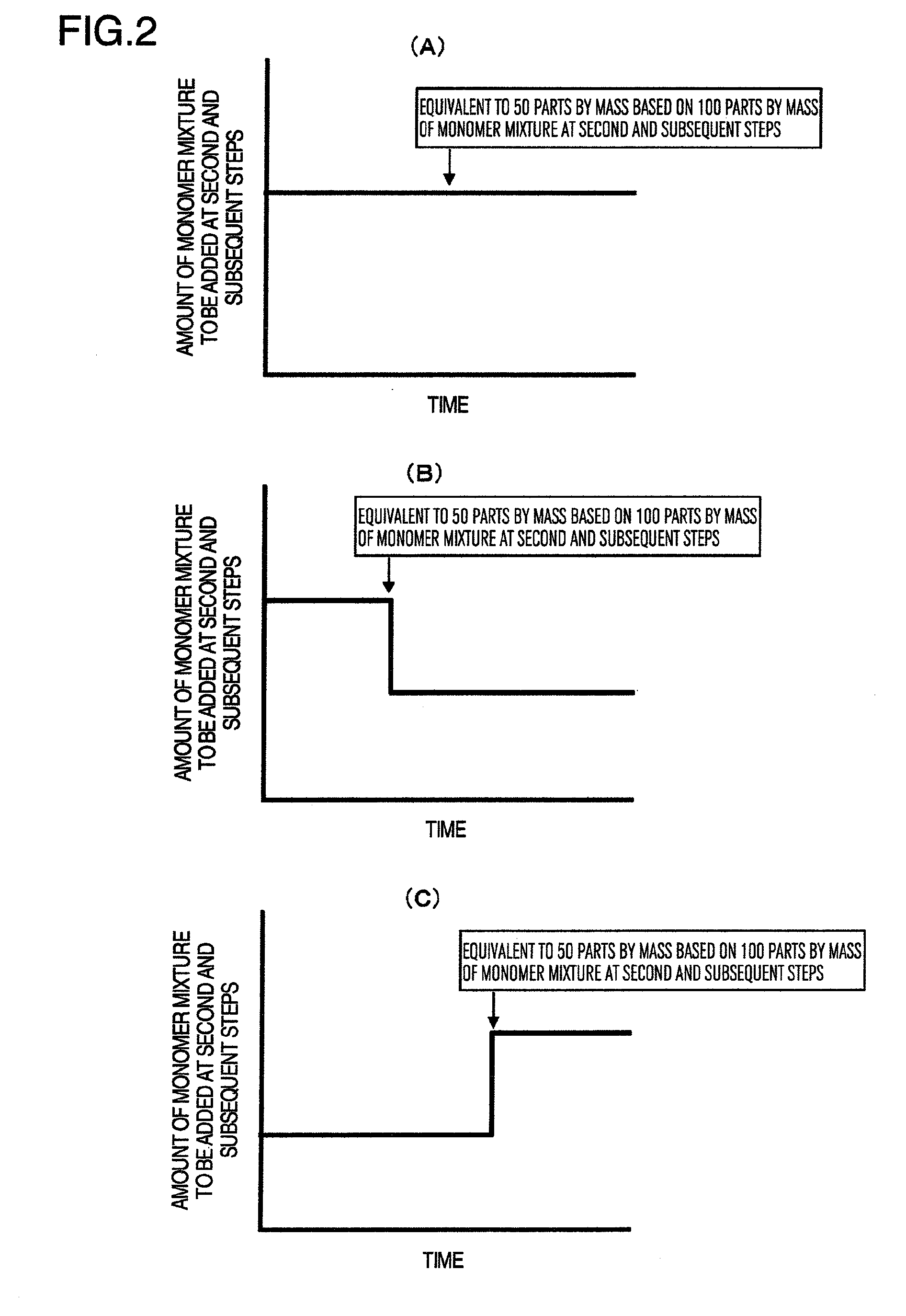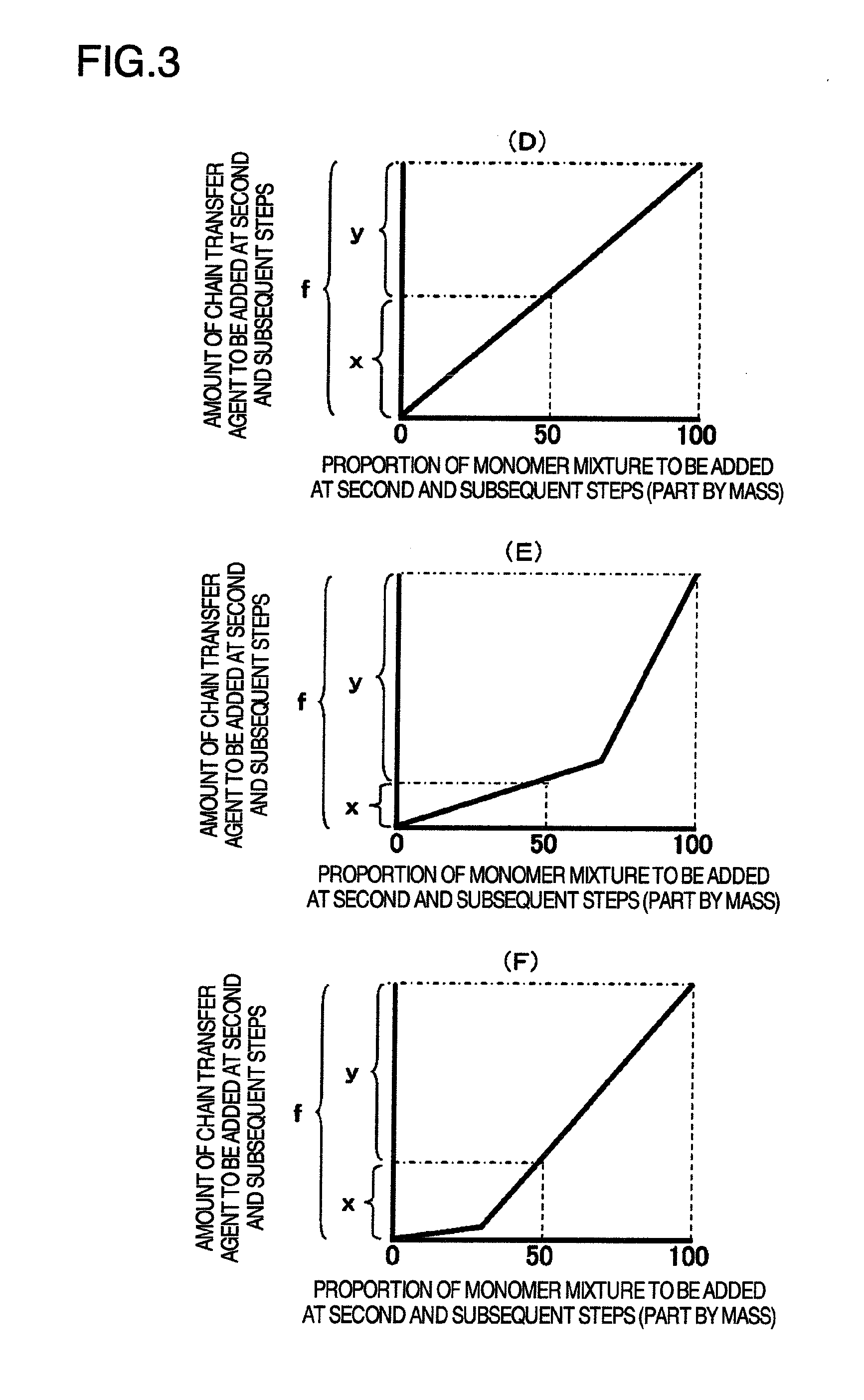Copolymer latex and method for producing the same
a copolymer and latex technology, applied in the field of cop, can solve the problems of easy blistering of the coating, damage to the incinerator, and reduced chipping resistance, and achieve the effects of reducing the weight of the vehicle, and reducing the chipping resistan
- Summary
- Abstract
- Description
- Claims
- Application Information
AI Technical Summary
Benefits of technology
Problems solved by technology
Method used
Image
Examples
examples
[0084]Next, the present embodiment will be more specifically described using Examples and Comparative Examples, but the embodiment will not be limited to Examples given below without departing from the gist thereof. Evaluation of respective physical properties was performed with the methods as follows.
(1) Toluene-Insoluble Matter and Degree of Swelling in Toluene
[0085]A copolymer latex whose concentration of a solid content was adjusted at 50% and pH was adjusted at 8 was dried for 30 minutes at 130° C. to obtain a dry substance (latex film). After 0.5 g of this latex film was mixed with 30 ml of toluene, and shaken for 3 hours, the solution was filtered with a metallic net having an opening of 32 μm. Then, the wet mass and dry mass of the residue were weighed. The proportion of the dry mass of the residue to the mass of the original latex film was defined as toluene-insoluble matter (% by mass). The ratio of the wet mass to the dry mass of the residue was defined as a degree of swe...
production example a1
[0097]As an initial raw material for polymerization, an initial raw material for polymerization containing 75 parts by mass of water, 0.6 parts by mass of sodium dodecyldiphenyletherdisulfonate, and a seed latex made of 3.0 parts by mass of polystyrene having the number average particle size of 65 nm was prepared in a pressure-resistant reaction container in batch, and sufficiently stirred at 70° C. Next, a mixture of a monomer for a first polymerization step and a chain transfer agent described in Table 1 and prepared for the first polymerization step (hereinafter, abbreviated as “mixture of a monomer and the like”) was continuously added into this pressure-resistant container at a constant flow rate over 2 hours 45 minutes. On the other hand, after 10 minutes when this addition started, addition of an aqueous mixture made of 20 parts by mass of water, 0.15 parts by mass of sodium hydroxide, 0.2 parts by mass of sodium dodecyldiphenyletherdisulformate, and 0.8 parts by mass of sodi...
example 1
[0107]Copolymer latex A1 and the following materials were used and mixed uniformly to prepare a composition for an aqueous coating. The following blending (parts by mass) is expressed with values all converted into a solid content except water.
Copolymer latex (A1)100parts by massHeavy calcium carbonate200parts by massDispersing agent1part by massAntifoaming agent0.2parts by massThickener3parts by mass
[0108]A trade name BF-300 (made by SHIRAISHI CALCIUM KAISHA, LTD.) was used for heavy calcium carbonate. A trade name Poise 530 (made by Kao Corp.) was used for the dispersing agent. A trade name SN Defoamer 777 (made by SAN NOPCO LIMITED) was used for the antifoaming agent. A trade name SN thickener A813 (made by SAN NOPCO LIMITED) was used for the thickener.
[0109]Next, using a spatula, the thus-obtained composition for an aqueous coating was applied onto an electrodeposited plate so that the film thickness of the coating film might be 400 μm. The coating film was formed by drying for ...
PUM
| Property | Measurement | Unit |
|---|---|---|
| number average particle size | aaaaa | aaaaa |
| glass transition ending temperature | aaaaa | aaaaa |
| glass transition ending temperature | aaaaa | aaaaa |
Abstract
Description
Claims
Application Information
 Login to View More
Login to View More - R&D
- Intellectual Property
- Life Sciences
- Materials
- Tech Scout
- Unparalleled Data Quality
- Higher Quality Content
- 60% Fewer Hallucinations
Browse by: Latest US Patents, China's latest patents, Technical Efficacy Thesaurus, Application Domain, Technology Topic, Popular Technical Reports.
© 2025 PatSnap. All rights reserved.Legal|Privacy policy|Modern Slavery Act Transparency Statement|Sitemap|About US| Contact US: help@patsnap.com



